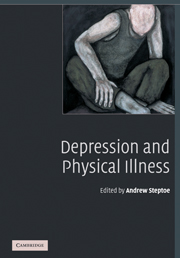Book contents
- Frontmatter
- Contents
- List of contributors
- Preface
- Part 1 Introduction to depression and its determinants
- Part 2 Depression and specific health problems
- 3 Depression and the development of coronary heart disease
- 4 Depression and prognosis in cardiac patients
- 5 The management of depression in patients with coronary heart disease
- 6 Depression and physical disability
- 7 Chronic pain and depression: twin burdens of adaptation
- 8 The interrelationship of depression and diabetes
- 9 Depression and chronic fatigue
- 10 Cancer and depression
- 11 Depression and obesity
- Part 3 Biological and behavioural processes
- Part 4 Conclusions
- Index
- References
7 - Chronic pain and depression: twin burdens of adaptation
from Part 2 - Depression and specific health problems
Published online by Cambridge University Press: 17 September 2009
- Frontmatter
- Contents
- List of contributors
- Preface
- Part 1 Introduction to depression and its determinants
- Part 2 Depression and specific health problems
- 3 Depression and the development of coronary heart disease
- 4 Depression and prognosis in cardiac patients
- 5 The management of depression in patients with coronary heart disease
- 6 Depression and physical disability
- 7 Chronic pain and depression: twin burdens of adaptation
- 8 The interrelationship of depression and diabetes
- 9 Depression and chronic fatigue
- 10 Cancer and depression
- 11 Depression and obesity
- Part 3 Biological and behavioural processes
- Part 4 Conclusions
- Index
- References
Summary
Introduction
It is estimated that chronic pain afflicts between 50 and 80 million people in the USA [1]. Adding to this burden of pain, feelings of depression frequently accompany the pain [2]. These depressive symptoms include feelings of sadness, loss of pleasure and fatigue and range in severity from transient malaise to persistent and debilitating episodes. For many people, it is common sense that negative feelings would follow painful experiences, but a number of researchers have noted that depressed patients frequently report high levels of pain as well. Not only is pain a common somatic complaint in individuals suffering from depressive disorders [3], but also, according to some accounts, more than 50% of clinically depressed patients report pain as a symptom [4]. Not all investigators use the same criteria to determine the presence of depression, and so the exact prevalence of depression among patients with chronic pain is not easy to estimate [5]. Banks and Kerns [6] reviewed only studies that used standardised criteria to diagnose depressive disorders and estimated that at any given point 30–54% of clinic-based patients suffer from major depressive disorder (MDD), a rate substantially higher than that found in the general population [7] and higher than in out-patients of other medical conditions.
Thus, there appears to be a strong association between depressive symptoms and persistent pain, but the underlying causal mechanisms remain poorly understood.
Keywords
- Type
- Chapter
- Information
- Depression and Physical Illness , pp. 145 - 164Publisher: Cambridge University PressPrint publication year: 2006
References
- 2
- Cited by



